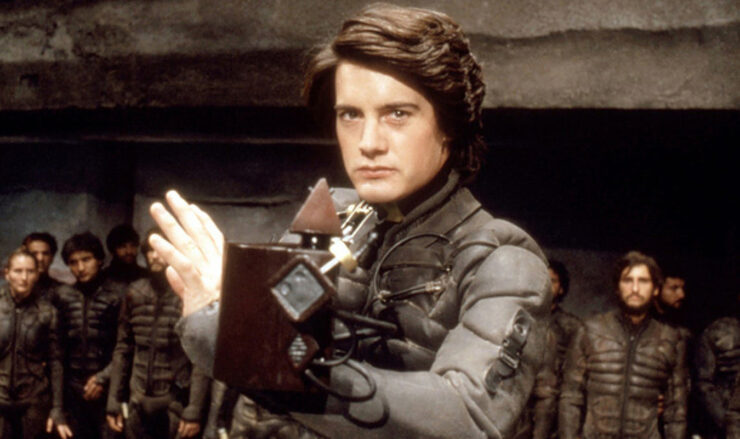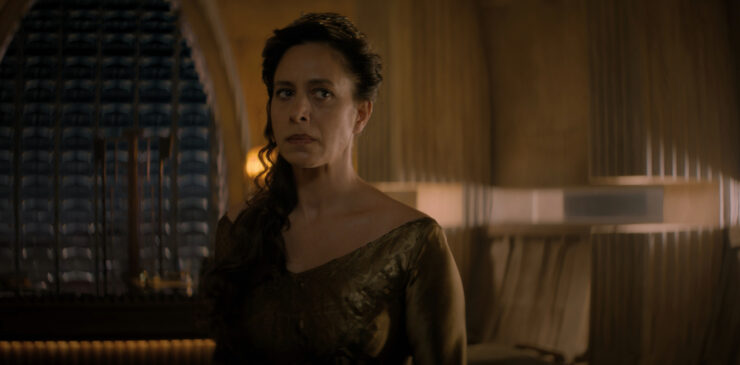If you’re looking for full gender equality in Dune, you may be let down. But if you want to see an order of women who shape humanity through control of mind, body, religion, and politics, welcome to Frank Herbert’s multi-layered masterpiece of worldbuilding.
To properly analyze the women in Dune—specifically the members of the Bene Gesserit Sisterhood—we need to recognize the complexity of their characterization and activities within the larger context of the world. Many, though not all, of their roles fall within the boundaries of those traditionally held by women. The main female character, Lady Jessica, for example, is a concubine, mother, advisor, and religious leader.
This makes sense as such roles fit within the feudal, medieval-style world that Herbert creates. It is not a reason to dismiss Dune’s female characters as weak, inferior, or passive, as some critics have done. Herbert makes the Bene Gesserit a believable part of his world while showing how its members exert agency in the face of plausible limitations and tensions in life. The women of the Bene Gesserit are active, influential, and powerful, even if not in the ways we might expect.
Feudal/Medieval Setting
First, we must acknowledge that the story takes places in a feudal, medieval-type setting where difference, rather than equality, is rewarded.
The opening chapter tells us straight away that this is not a universe where people are equal. The Imperium maintains the rigid faufreluches class system, where each person has their place.
At the point we enter this universe, factions have already carved out their niches based on their specializations. The Guild can pilot ships through space, giving them a monopoly on transport. Mentats can perform feats of logic, giving them roles as strategists to the nobility. Suk Doctors undergo conditioning to become trusted practitioners of medicine, making them safe enough to minister to the highest-ranked nobility.
This is a hierarchical world with dukes, counts, barons, and an emperor at the top. It is not a place where we would expect to see equality of any kind, including gender equality.
Yet there exists a faction of women with significant influence: the Bene Gesserit. It is a silent partner in the universal development corporation, CHOAM. It has a compact with the emperor forcing him to place one of its members on the throne, and also placing a Truthsayer at his side to advise him. It sends women out as partners to noblemen and secures valuable bloodlines for its secret breeding program. It deploys agents throughout the universe spreading myths and legends as missionaries in case of future need. By specializing in mastery of the mind and body, the group secures a unique niche of influence.
For such an all-female faction to make sense in this setting, the Bene Gesserit must be grounded in elements from the real world. And indeed it is.
Worldbuilding
In creating Dune, Herbert wanted to explore certain features of politics and religion, as well as the potential of the human mind and body. He used the Bene Gesserit as a key means of doing so. But in choosing to have this group be comprised of women, he had to position them in a way that makes sense within a universe of hierarchies and traditional male leadership.
Creating a fictional world in which readers can fully immerse themselves means ensuring that it is believable, that the elements fit together to form a coherent world logic. [Mark J.P. Wolf, Building Imaginary Worlds: The Theory and History of Subcreation, Taylor & Francis, 2012] As J.R.R. Tolkien once noted, anyone can write about a “green sun,” but to make such a thing credible within a writer’s fantasy world requires work, thought, and a special skill. Thus, writers often turn to the real world for inspiration while also making modifications to make their world science fictional or fantastical.
Herbert drew on influences from both Western and Eastern religions and philosophies to characterize women who can perform all of the feats and activities the Bene Gesserit undertake, without it seeming strange or out of place.
Catholic Influences
The most obvious connection between the Bene Gesserit with the real world is the Catholic Church, which Herbert transforms into an all-female organization that eschews celibacy and deity worship in favor of a comprehensive breeding program and the guise of religious mysticism. Indeed, the Bene Gesserit closely aligns with the Catholic Church of the medieval and Early Modern periods.
Rather than installing religious leaders such as popes as temporal rulers, the Church exerted a great deal of political influence through indirect channels. It overheard confessions, demanded tithes, threatened excommunication, launched crusades, and approved or disapproved of annulments, among other activities. It sanctioned orders such as the Jesuits, as well as monasteries and nunneries. It sent missionaries to the far corners of the globe to educate, convert, and increase its sphere of influence. If we look at how long the Church has survived, we can see that it has had a significant and long-lasting impact on societies and cultures around the world.
The Bene Gesserit has chosen to wrap itself in the cloak of religious mysticism to play politics from an indirect position similar to the one the Church inhabited in the medieval and early modern world. The sisterhood embeds women throughout the universe in a variety of positions, low and high, and obtains firsthand access to information and opportunities to shape the course of history. It even claims the authority to separate truth from falsehood, just as various religious clerics and scholars have done in their selection of canonical texts and interpretations of scripture. The order also embraces the idea of service and strategic sacrifice—that being part of a collective often means giving up personal desires for the group’s goals or a higher cause.
There is likewise a parallel between high-ranking women of the Bene Gesserit, namely Reverend Mother Gaius Helen Mohiam, and abbesses in the medieval Church. Although women were disallowed from official leadership roles in the Church, they could hold the office of abbess, which was an influential leadership position for women in medieval society. According to The Catholic Encyclopedia, abbesses had power, authority, and distinction that could rival that of bishops and abbots. They treated with nobility on equal terms and signed their names to royal charters. Some even disobeyed the rules of their religion and heard confessions.
Reverend Mother Mohiam, in her role as advisor and Truthsayer to the Emperor, shows us a woman who is clearly moving in high political circles just as some abbesses were able to.
It would certainly have been possible for Herbert to have crafted a very different vision of the Bene Gesserit—to have made its members all men, like the Church leadership or Jesuit order, perhaps, or simply to have placed a male cleric in charge. Instead, he develops an order that encourages women to actively participate in a long-term strategy to exert control over the direction of humanity.
Eastern Influences
The Bene Gesserit organization is not merely a thinly-veiled Catholic Church—another real-world influence on their creation was drawn from Eastern traditions. Anticipating the wave of interest in Eastern religions and philosophies by the U.S. counterculture in the 1960s, Herbert threaded his novel with concepts and ways of viewing the world that extend beyond a Western paradigm. The Bene Gesserit is one manifestation of this influence in Dune. The very terminology of its Bene Gesserit Way and training in prana-bindu signals a link with concepts of balance and self-control in Taoism and Hinduism.
Rather than privileging the mind as traditional Western philosophy has done for generations, members of the Bene Gesserit seek a balance between mind and body. This allows them to train themselves to accomplish extraordinary feats such as going into hibernation or neutralizing poisons.
The Bene Gesserit order abides by a type of Taoist philosophy that recognizes success through moving in harmony with the universe rather than resisting it. Taoism contains the concept of wu wei, a strategy of non-action that paradoxically allows the most effective action to happen. One example of this concept at work is water, which seems to be soft and have no effect as it runs down a mountainside on the course of least resistance. Yet over time, water can reshape the hardest mountains by carving paths through them.
The Bene Gesserit’s operations align with this way of thinking about action and long-term change. This is not passivity but a different kind of activity. One such example is articulated in the novel by Reverend Mother Mohiam, who was one of Jessica’s teachers at school, when she states: “‘That which submits rules.’…The willow submits to the wind and prospers until one day it is many willows—a wall against the wind. This is the willow’s purpose.”
What initially seems counterintuitive—for the willow to let the wind blow it over rather than stand and resist it—allows the willow to thrive and reproduce until eventually it can stand strong against the force of wind. In a similar way, members of the Bene Gesserit are content to be patient and work within existing systems to accomplish their goals, as they hope to do with their generations-long breeding program.
Even if we are not familiar with such aspects of Eastern religions and philosophies ourselves, they still contain an underlying logic that helps make the philosophy of the Bene Gesserit believable. This is a principle of good worldbuilding that adds consistency to the world and also rewards subsequent readings, when we can bring a new perspective to the text and make new connections. [Wolf]
Women’s Agency
All of the above facets of the Bene Gesserit make it trickier to analyze the representation of these women, for it is not enough to look simply at their roles, level of equality, or rank in the power hierarchy.
So, in my research and writing about the Bene Gesserit, I have chosen to use the framework of agency. I define agency as the capacity for control over one’s body and life, and the ability to actively influence event outcomes, within the limitations of one’s environment or context. This offers a useful way of showing how women are active, influential, and powerful characters in Dune even though they may not necessarily have traditional markers of authority.1
Bene Gesserit women exert agency in a variety of areas, including politics, religion, education, and history. Since Jessica is the most prominent Bene Gesserit woman in Dune, she is the main window we have into their agency and the skills that help facilitate it. We know these skills are part of her training and see her passing on her lessons in training her son, Paul Atreides. We also see examples of other Bene Gesserit women using similar skills, so we assume that they are common to members of the order.
At the heart of it all is their ability to control every nerve and muscle of the body through their training in prana-bindu. From this stems other types of control, including reproductive control which lets them choose when to conceive and determine the sex of their child. They have formidable fighting skills and can engage in hand-to-hand combat without relying on weapons. In fact, they are considered more skillful than the Emperor’s legendary Sardaukar troops, as per Dune’s Terminology of the Imperium.
The Bene Gesserit have exceptional vocal control through the Voice, where they pitch their voice to a certain register in order to subconsciously control others. They can either compel others to physically move or persuade them of an idea with encouragement beyond ordinary persuasion.
Buy the Book


Spear
Their physical abilities enable and enhance their mental capabilities as well, such as when they undergo the spice agony and expand their consciousness to include their female ancestors. This provides them with additional information, wisdom, and resources with which to make decisions.
Their skills in precise perception mean they can pick out minute details that most people would miss. This allows them to better understand their environment, other people, and themselves. Bene Gesserit can also perform Truthsaying, making them a kind of human lie detector, and can implant trigger words into a person’s psyche in order to control their body at a later time of their choosing.
Beyond their prana-bindu training is education in multiple languages, espionage, diplomacy, and religious creeds, among others. They are prepared to actively engage in the world in a multitude of ways.
As discussed above, these abilities are designed to be grounded in reality rather than magical or supernatural. They are based on Herbert’s years of research on subjects such as biofeedback, meditation and yoga practices, and social sciences like linguistics and psychology (although some of the psychoanalytical aspects of the collective unconscious and Other Memory may seem like a stretch).
Even though some characters try to label the Bene Gesserit as “witches,” this is because they are afraid of what they cannot explain and fearful of powerful women. It is not because there is magic or occult influences at work. Their abilities are based on strict training, and we see a young man, Paul, master these skills as well, thanks to his mother’s instruction.
What the women of the Bene Gesserit do with all of these extraordinary abilities is pursue their ultimate goals. The precise nature of their grand design is kept mysterious, but essentially boils down to wanting to direct human affairs through politics and religion. They do this through a variety of activities. They test for humans so that they can prevent people from falling prey to animalistic instincts and being enslaved by thinking machines again. They spread religious propaganda via the Missionaria Protectiva to secure boltholes across the universe. They make alliances with ruling families and organizations just as has been done throughout history.
Outside of the main storyline, we also see Princess Irulan’s significant role as a historian, with excerpts from her writing framing each chapter and shaping how we interpret the events that unfold within.
The Kwisatz Haderach Question
The fact that the Bene Gesserit also operates a woman-controlled breeding program aimed at producing a male Bene Gesserit called the Kwisatz Haderach is often a stumbling block for readers in understanding this organization.
A common critique is leveled at the Sisterhood: if its women are so skillful and powerful, why are they aiming to produce a male superhuman who can bridge space and time with his mental powers?
There are several possible in-universe answers.
Given their philosophy and mode of operations within the feudal culture, it would make sense to have a male figure who could slot seamlessly into the existing power structure. It is implied that the order desired this man as a tool through which it could wield power, albeit at a distance, being wise to the idea that power can be a corruptive force. Herbert himself hinted at this rationale in one of his interviews. A man being controlled by the order behind the scenes might raise fewer suspicions and more covertly facilitate the realization of its agenda.
If we consider the name of the Kwisatz Haderach—Paul—it alludes to Christianity’s great apostle who is credited for much of the initial spread of the faith in Europe and Asia Minor. Though he appears a generation early, Paul steps into the role of messiah that Bene Gesserit women have already prepared via their legends, in effect proving the shrewdness of their plan. He leverages this to become a powerful ruler, but eventually slips out of their control.2
There are also possible out-of-universe explanations.
Herbert repeatedly stated how he wrote Dune to explore the superhero mystique and humanity’s susceptibility to hero worship, allowing powerful and charismatic leaders take over their decision-making capability. It makes sense that he would want a heroic male figure who could resemble the kind of real-world men he was implicitly warning readers against, such as Winston Churchill, Franklin Delano Roosevelt, John F. Kennedy, or General George Patton. [Frank Herbert, “Dangers of the Superhero”, The Maker of Dune, p. 98]
Yet even though he chose to create a male superhero to serve as the focus of this critique, Herbert does not leave women out of the picture or absolve them from blame. He demonstrates that women, too, can be criticized for taking advantage of humanity’s weaknesses and exerting power for their own aims. We do not see the Bene Gesserit order find success in controlling its Kwisatz Haderach, despite generations of careful attention to the breeding program. There is even an appendix in Dune noting the Bene Gesserit’s errors in its actions regarding Paul.
Instead, we see the irony in a powerful organization that has spent generations cultivating a religious mystique and spreading propaganda for its own ends being laid low by these same things, losing control over its carefully planned endgame. This is part of Herbert’s commentary on the dangers of people seeking after power and domination, and the depiction of the Bene Gesserit highlights that this includes women as well as men.
Herbert was also influenced by the psychology of Carl Jung (1875-1961). Jung theorized about dualistic principles of the masculine and feminine in the unconscious of men and women, but also how a balance or combination of elements—a type of androgyny—made for a fuller personality. [Zuyan Zhou, “Androgyny”, Oxford Encyclopedia Women in World History, Oxford University Press, 2008] Herbert appears to accept such a dualistic view in the descriptions of the inward place that the Bene Gesserit fear to look but which Paul can access. Yet he also shows Paul becoming a kind of androgynous figure—a male Bene Gesserit who is neither fully masculine nor feminine but exists “at the fulcrum.” [Dune, p. 445] It is seemingly by embracing the feminine element, rather than suppressing it, that Paul is able to achieve what he does.
Limitations and Tensions
By including both successes and shortcomings in his depiction of the Bene Gesserit, Herbert makes it a more nuanced, multi-faceted organization, and he does something similar for individual women in the narrative by showing limitations on their agency.
Sometimes they are prevented from acting, such as when the Harkonnen have Jessica gagged and watched over by a deaf guard so that she cannot use the Voice, or when the Fremen disallow her from acting as her own champion after Jamis’ challenge.
Sometimes they are not listened to, such as when Reverend Mother Mohiam is silenced by the Emperor and Paul during their final confrontation.
Sometimes they have only one viable option to choose, such as when Jessica risks her unborn daughter to take the Water of Life to secure safety among the Fremen, or when Princess Irulan offers to marry Paul to facilitate a smooth transition of power.
Women of the Bene Gesserit also face tensions between pursuing their individual desires and furthering the goals of the collective. For instance, Jessica decides to have a son not solely to fulfil Duke Leto’s desire for a male heir in the feudal society of the Imperium, but also to pursue her own dream of raising the long-awaited end product of the breeding program. Reverend Mother Mohiam says it plainly: “What you did, Jessica, and why you did it—we both know. But kindness forces me to tell you there’s little chance your lad will be the Bene Gesserit Totality. You mustn’t let yourself hope too much.”
Reverend Mother Mohiam herself tacitly approves of Jessica’s behavior in subverting regulations to train Paul, stating, “You’ve been training him in the Way—I’ve seen the signs of it. I’d have done the same in your shoes and devil take the Rules.” [Dune, p. 27] She even goes on to instruct Jessica to teach Paul to master the Voice for his own safety. There is clearly a bond between these women that eclipses their loyalty to the Sisterhood, if only for a brief period.
Later in the narrative, we see that in spite of Jessica’s disobedience, she remains a Bene Gesserit. When she realizes Paul has indeed become the Kwisatz Haderach, her first thought is to inform the Sisterhood, though she is unable to. This reminds us of her conflicted loyalties and gives her character greater depth than if she were either a complete rebel or a committed devotee.
The depiction of plausible tensions, difficulties, and limitations in women’s lives provides valuable complexity to the representation of Bene Gesserit women. It enables these female characters to appear more three-dimensional, as opposed to being mere stock characters or stereotypes. They aim for balance, not extremes, as they navigate their way in the Imperium according to their own philosophy and method of operations. And even though one of their instruments—Paul—resists their control, he is still fundamentally shaped by Bene Gesserit training and has little choice but to follow the Kwisatz Haderach path of their design.
Dune is renowned for its worldbuilding, and the Bene Gesserit order forms a key part of the universe. It should be recognized as a vehicle for Herbert’s larger messages about power, politics and religion, as well as a way for him to show women as active, influential, and powerful figures in their own right.
Kara Kennedy, PhD, is a researcher and writer in the areas of science fiction, digital literacy, and writing. This article is based on her upcoming book on Bene Gesserit women in the Dune series. She has published academic articles on worldbuilding in the Dune series and has other works about the series forthcoming. She posts literary analyses of Dune for a mainstream audience on her blog at DuneScholar.com.
[1]See “Queenship and the Women of Westeros: Female Agency and Advice in Game of Thrones and A Song of Ice and Fire” (https://www.palgrave.com/gp/book/9783030250409) for an example of the agency approach used to analyze a fantasy series.
[2]In later books in the series, the Sisterhood does successfully birth and raise a male child to become one of its great military commanders, and he respects and obeys the order’s authority.














